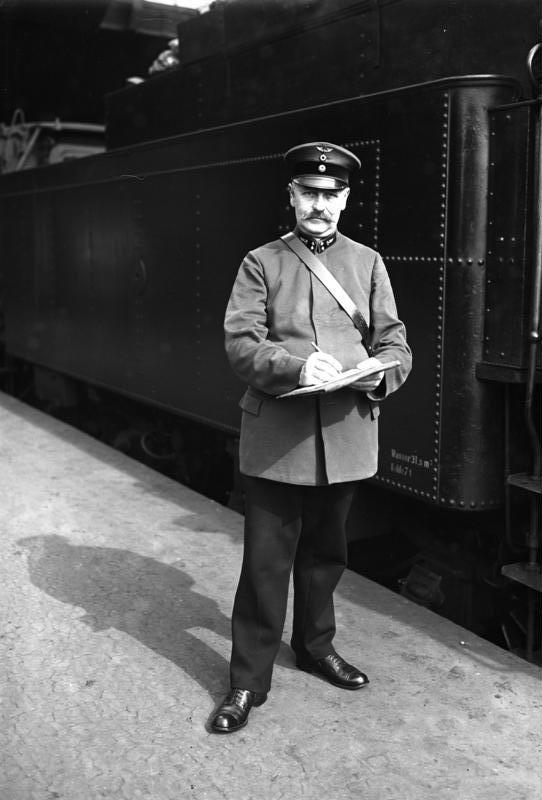|
Palatine T 4.I
The locomotives of Palatine Class T 4I were saturated steam tank engines operated by the Palatinate Railway. Krauss delivered four of them in 1895 and a further three in 1897. The development of these engines had been based on the second batch of Bavarian D VIII engines and they differed only in a few dimensions: for example, the diameter of the carrying and coupled wheels was smaller. In addition they had a larger coal tank. In 1908 and 1910 Krauss supplied two batches, each of four locomotives, which were now designated the Palatine D VIII. These differed in having a larger fuel tank and a higher maximum boiler pressure: 13 as opposed to 12 bar. In 1925 the Deutsche Reichsbahn took over all 15 locomotives and grouped them together with the Bavarian D VIII into DRG Class 98.6. The first seven machines were allocated numbers 98 651–657 and the eight newer ones numbers 98 681–688. The first group was retired by 1940, the second survived to join the Deutsche Bundesbahn fleet. ... [...More Info...] [...Related Items...] OR: [Wikipedia] [Google] [Baidu] |
Krauss & Co
Krauss is a German surname. Notable people with the surname include: * Alison Krauss (born 1971), American bluegrass musician * Alexander Krauß (born 1975), German politician * Alexis Krauss (born 1985), musician of the noise pop duo Sleigh Bells * Anna Krauss (born 1884) German clairvoyant * Beatrice Krauss (1903–1998), American botanist * Clemens Krauss (1893–1954), Austrian conductor * Charles A. W. Krauss (1851–1939), American politician * Christian Ferdinand Friedrich Krauss (1812–1890), known as Ferdinand Krauss, German scientist, traveller and collector * Friedrich Salomon Krauss (1859–1938), Austrian ethnographer * Gabrielle Krauss (1842–1906), Austrian-born French operatic soprano * Georg Krauß, (1826–1906), German industrialist and the founder of the Krauss Locomotive Works ** Krauss-Maffei, German engineering company, named in part after Georg Krauß * Hermann August Krauss (1848–1937), Austrian entomologist * Johan Carl Krauss (1759–1826), German phy ... [...More Info...] [...Related Items...] OR: [Wikipedia] [Google] [Baidu] |
Deutsche Bundesbahn
The Deutsche Bundesbahn or DB (German Federal Railway) was formed as the state railway of the newly established Federal Republic of Germany (FRG) on 7 September 1949 as a successor of the Deutsche Reichsbahn-Gesellschaft (DRG). The DB remained the state railway of West Germany until after German reunification, when it was merged with the former East German Deutsche Reichsbahn (DR) to form Deutsche Bahn, which came into existence on 1 January 1994. Background After World War II, each of the military governments of the Allied Occupation Zones in Germany were ''de facto'' in charge of the German railways in their respective territories. On 10 October 1946, the railways in the British and American occupation zones formed the ''Deutsche Reichsbahn im Vereinigten Wirtschaftsgebiet'' (German Imperial Railway in the united economic area), while on 25 June 1947, the provinces under French occupation formed the Südwestdeutsche Eisenbahn. With the formation of the FRG these succe ... [...More Info...] [...Related Items...] OR: [Wikipedia] [Google] [Baidu] |
Standard Gauge Locomotives Of Germany
Standard may refer to: Symbols * Colours, standards and guidons, kinds of military signs * Heraldic flag, Standard (emblem), a type of a large symbol or emblem used for identification Norms, conventions or requirements * Standard (metrology), an object that bears a defined relationship to a unit of measure used for calibration of measuring devices * Standard (timber unit), an obsolete measure of timber used in trade * Breed standard (also called bench standard), in animal fancy and animal husbandry * BioCompute Object, BioCompute Standard, a standard for next generation sequencing * De facto standard, ''De facto'' standard, product or system with market dominance * Gold standard, a monetary system based on gold; also used metaphorically for the best of several options, against which the others are measured * Internet Standard, a specification ratified as an open standard by the Internet Engineering Task Force * Learning standards, standards applied to education content * Stand ... [...More Info...] [...Related Items...] OR: [Wikipedia] [Google] [Baidu] |
Krauss Locomotives
Krauss is a German surname. Notable people with the surname include: * Alison Krauss (born 1971), American bluegrass musician * Alexander Krauß (born 1975), German politician * Alexis Krauss (born 1985), musician of the noise pop duo Sleigh Bells * Anna Krauss (born 1884) German clairvoyant * Beatrice Krauss (1903–1998), American botanist * Clemens Krauss (1893–1954), Austrian conductor * Charles A. W. Krauss (1851–1939), American politician * Christian Ferdinand Friedrich Krauss (1812–1890), known as Ferdinand Krauss, German scientist, traveller and collector * Friedrich Salomon Krauss (1859–1938), Austrian ethnographer * Gabrielle Krauss (1842–1906), Austrian-born French operatic soprano * Georg Krauß, (1826–1906), German industrialist and the founder of the Krauss Locomotive Works ** Krauss-Maffei, German engineering company, named in part after Georg Krauß * Hermann August Krauss (1848–1937), Austrian entomologist * Johan Carl Krauss (1759–1826), German ph ... [...More Info...] [...Related Items...] OR: [Wikipedia] [Google] [Baidu] |
Railway Locomotives Introduced In 1895
Rail transport (also known as train transport) is a means of transport that transfers passengers and goods on wheeled vehicles running on rails, which are incorporated in tracks. In contrast to road transport, where the vehicles run on a prepared flat surface, rail vehicles (rolling stock) are directionally guided by the tracks on which they run. Tracks usually consist of steel rails, installed on sleepers (ties) set in ballast, on which the rolling stock, usually fitted with metal wheels, moves. Other variations are also possible, such as "slab track", in which the rails are fastened to a concrete foundation resting on a prepared subsurface. Rolling stock in a rail transport system generally encounters lower frictional resistance than rubber-tyred road vehicles, so passenger and freight cars (carriages and wagons) can be coupled into longer trains. The operation is carried out by a railway company, providing transport between train stations or freight customer faciliti ... [...More Info...] [...Related Items...] OR: [Wikipedia] [Google] [Baidu] |
Palatine Locomotives
A palatine or palatinus (in Latin; plural ''palatini''; cf. derivative spellings below) is a high-level official attached to imperial or royal courts in Europe since Roman Empire, Roman times."Palatine" From the ''Oxford English Dictionary''. Retrieved November 19, 2008. The term ''palatinus'' was first used in Ancient Rome for Chamberlain (office), chamberlains of the Emperor due to their association with the Palatine Hill. The imperial palace guard, after the rise of Constantine I, were also called the ''Scholae Palatinae'' for the same reason. In the Early Middle Ages the title became attached to courts beyond the imperial one; one of the highest level of officials in the papal administrati ... [...More Info...] [...Related Items...] OR: [Wikipedia] [Google] [Baidu] |
List Of Palatine Locomotives And Railbuses
This list gives an overview of the locomotives and railbuses of the Palatinate Railway (''Pfalzbahn'') and the Palatine network of the Royal Bavarian State Railways (''Königlich Bayerische Staats-Eisenbahnen''). The Palatinate (''Pfalz'') is a region in south-western Germany that became part of the Kingdom of Bavaria in 1816, even though it was geographically separate. Its union with Bavaria was not dissolved until the reorganisation of German states after World War II during the occupation of Germany. The Palatinate Railway was a private railway concern formed on 1 January 1870. It was nationalised on 1 January 1909, with its 870 kilometres of track, and went into the Royal Bavarian State Railways. Overview Palatine locomotives were numbered in sequence as well as given names. On being retired, the numbers freed up were reused for newly delivered locomotives. Pontoon locomotives(''Schiffsbrückenlokomotiven''), as well as engines employed on secondary (''Sekundärbahn'') ... [...More Info...] [...Related Items...] OR: [Wikipedia] [Google] [Baidu] |
Augsburger Localbahn
The is an endangered German breed of domestic chicken. It originates from the area of the city of Augsburg, in the Swabian region of the state of Bavaria, in southern Germany. It was bred in the nineteenth century, and derives mostly from the French La Flèche breed. It is the only chicken breed of Bavarian origin. History The Augsburger was created by Julius Meyer, of the small town of Haunstetten, now part of the city of Augsburg, in the Swabian region of the state of Bavaria, in southern Germany. In 1870 or 1880, he cross-bred birds of the French La Flèche breed, prized for the quality of its meat, with an Italian breed or type – now extinct – named Lamotta, which was a good layer of eggs. The aim was to create a dual-purpose chicken which would combine both qualities. The first written description of the Augsburger is that of Jean Bungartz in 1885. The Augsburger became popular, and spread to the area of Stuttgart and as far as the Black Forest. A breeders' as ... [...More Info...] [...Related Items...] OR: [Wikipedia] [Google] [Baidu] |
Deutsche Reichsbahn
The ''Deutsche Reichsbahn'', also known as the German National Railway, the German State Railway, German Reich Railway, and the German Imperial Railway, was the German national railway system created after the end of World War I from the regional railways of the individual states of the German Empire. The ''Deutsche Reichsbahn'' has been described as "the largest enterprise in the capitalist world in the years between 1920 and 1932"; nevertheless its importance "arises primarily from the fact that the Reichsbahn was at the center of events in a period of great turmoil in German history". Overview The company was founded on 1 April 1920 as the ("German Imperial Railways") when the Weimar Republic, which still used the nation-state term of the previous monarchy, (German Reich, hence the usage of the in the name of the railway; the monarchical term was ), took national control of the German railways, which had previously been run by the German states. In 1924 it was reorganise ... [...More Info...] [...Related Items...] OR: [Wikipedia] [Google] [Baidu] |
Riggenbach Counter-pressure Brake
The counter-pressure brake (German: ''Gegendruckbremse''), also named the Riggenbach counter-pressure brake after its inventor, Niklaus Riggenbach, is a dynamic railway brake on steam locomotives that brakes the locomotive using the driving cylinders. In doing so it reduces wear and tear and overheating of the driving wheel tyres and brake blocks and enables a continuously high brake force to be applied. The brake works by using the cylinders as air compressors and converting kinetic energy into heat. Steam is emitted during braking but this does not come from the boiler, it is produced by evaporation of water used to cool the cylinders. The main part of the system is piping and regulation of atmospheric air drawn into the cylinders, into which cooling water and oil is injected. Operation To use the cylinders as pumps necessitates complete reversal of the normal gas flow. Atmospheric air is drawn through the steam exhaust and compressed air ejected through the steam inlet. A separa ... [...More Info...] [...Related Items...] OR: [Wikipedia] [Google] [Baidu] |
Boiler
A boiler is a closed vessel in which fluid (generally water) is heated. The fluid does not necessarily boil. The heated or vaporized fluid exits the boiler for use in various processes or heating applications, including water heating, central heating, boiler-based power generation, cooking, and sanitation. Heat sources In a fossil fuel power plant using a steam cycle for power generation, the primary heat source will be combustion of coal, oil, or natural gas. In some cases byproduct fuel such as the carbon monoxide rich offgasses of a coke battery can be burned to heat a boiler; biofuels such as bagasse, where economically available, can also be used. In a nuclear power plant, boilers called steam generators are heated by the heat produced by nuclear fission. Where a large volume of hot gas is available from some process, a heat recovery steam generator or recovery boiler can use the heat to produce steam, with little or no extra fuel consumed; such a configuration is common ... [...More Info...] [...Related Items...] OR: [Wikipedia] [Google] [Baidu] |

.gif)

